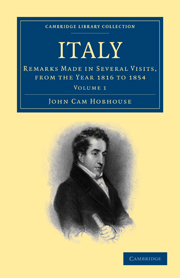Summary
One of the sights of Milan (in 1816) was the Arena, an open circus, the work of Canonici, said to be capable of containing 30,000 spectators, adapted for chariot races and other ancient games. The area can be flooded for the exhibition of “naumachia” on a small scale. This is the unfinished work of Napoleon, who was present at one of the games the year after he was crowned King of Italy. For some time after the change of government the circus was neglected, and the races discontinued; but the velvet throne of Napoleon, and two figures in the ceiling representing him and his empress Josephine, were shown at our first visit. At my next visit, in 1822, the empress was become a Minerva, and the former master of the iron crown was an old man with a beard. The Austrian government, after an interval, continued the work on the circus, and a few days before my third visit, in September, 1828, a boat-race was exhibited, the performers being gondoliers brought from Venice. Even then, however, the Arena was not finished: some of the stone-work being incomplete. The building will hold 30,000 spectators.
The passion for copying the ancients was encouraged by Napoleon, not only in Italy, but in France; but he wished his subjects to confine their imitations to the artists of Greece and Rome.
- Type
- Chapter
- Information
- ItalyRemarks Made in Several Visits, from the Year 1816 to 1854, pp. 51 - 62Publisher: Cambridge University PressPrint publication year: 2009First published in: 1859



